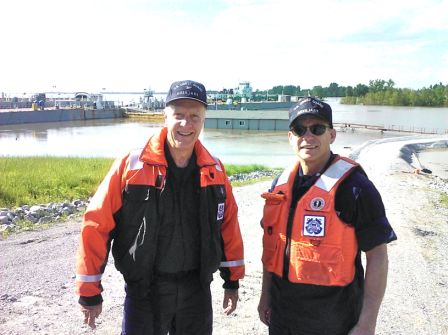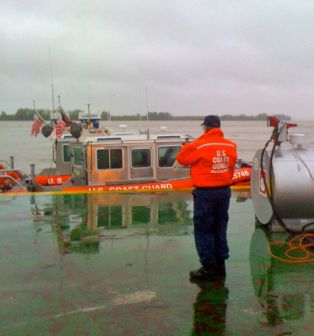

Article by Lynn Miles, District 8-Eastern Area Public Affairs Officer Photos by Larry Neltner of Flotilla 55, Newport, KY
 |
|
District Captain-West Rick Schal and Bob Powell, Division 5 Vice Commander with the local marine service barges in the background |
Paducah, KY — Commodore Rick Washburn, District Commodore of Eighth Eastern watched with most of the nation as the tornadoes ripped thru the south eastern sections of the U.S. on April 27th, 2011. He knew that many of his members from multiple divisions were in the path of these storms.
Less than 24 hours later, preparations began for a second, and possibly third and fourth natural disaster in his area of responsibility. The junction of the Lower Ohio and Mississippi rivers were flooding, possibly followed by the Cumberland River near Nashville, along with the Ohio River at Louisville.
Division 8 in Paducah, KY worked 24/7 with the active duty Coast Guard in support of Marine Safety Unit (MSU) Paducah during the floods there. The Coast Guard deployed 100 plus people, 4 safe boats, 2 Dart Teams, and other personnel to the area. Coast Guard helicopters and long range air assets flew over the rivers constantly, when weather permitted, performing over-flights in western Kentucky and eastern Missouri.
Division 11 sent their backwater flood boats to Paducah to assist and their Auxiliarists, trained in flood scenarios, were on standby. All eyes were now on the lower Ohio/Mississippi Rivers, where they merged, as well as the Cumberland River near Nashville.
MSU Paducah requested maximum Auxiliary support. Division 8 Commander Jimmie Hufnagel and members stepped up and worked at multiple roles in support of the MSU. Auxiliarists Hufnagel, Greg McKee, Joe Shallbetter, Mary Husfield, Nick Shull and Bill Husfield made up the 1st team that reported 30 Apr - 4 May 2011. Team 2 consisted of District Captain-West Rick Schal, Dale Yager, Bob Powell and Larry Neltner who reported on 3 May and were released on the 5th. These missions were supervised by the Officer in Charge at MSU Paducah.
The CG Cutter Chena became the command post as the water was too high to utilize the MSU’s facility. The Coast Guard used a dry dock facility at Woodlake and a civilian marina at Lake Barkley for staging.
As the waters rose, other cutters had to be repositioned to new docks. The CG Cutter Kankakee was moved to the river as she could no longer stay at a dock. The municipal airport at Lake Barkley was used to stage incoming and outgoing aircraft.
District Communications Officer Dave Stroup and his staff went on alert and prepared their radio equipment for deployment. Communications in that area were inconsistent with little internet access and limited cell phone coverage.
Bob Spera, our District Aviation Officer, worked with National staff, Air Station New Orleans and Air Traffic Control Center Mobile to coordinate the over-flights. Our partners in District 8-Central Region and District 8 - Western Region stood by with support as needed.
Division 8 Commander Jimmie Hufnagel made sure our Auxiliary members were safe. He had difficulty in contacting members of Flotilla 83, Metropolis Flotilla, as it was nearly impossible to get there by vehicle and there was no phone or internet access. There were mandatory evacuations in places and some voluntary evacuations as well.
Commodore Washburn was in contact with National Commodore Jim Vass and the Chief Director's office. All were aware of our situation and assisted us as needed.
Both Nashville and Louisville were also experiencing extreme weather. Randy Ventress, Division 11 Commander worked with Marine Safety Detachment Nashville in preparing for a flooding scenario.
Our District’s Operations Training Officer CWO3 Pinto, USCG, worked with Commodore Washburn as conditions deteriorated. It was looking more and more like Division 11 would require help from Division’s 1, 4, 5, 16, 12 and 24. All were notified and had members standing by willing to help.
The missions, tasks and logistics were strenuous at times, but our Auxiliarists proved to be “Semper Paratus”. Our members put in a total of combined 300 hours to support this mission. Members from various divisions worked seamlessly together.
 |
| Bob Powell, Division 5 Vice Commander, providing security for two boats. |
Here is a brief summary about one of the missions supplied by District Commader Jimmie Hufnagel and Auxiliarist Larry Neltner of Flotilla 55:
The mission - Auxiliary members provided boat watch/security of USCG boats docked on the river at Wickliffe, KY. They assisted USCG boats crews
with refueling as needed.
The logistics - The logistics for this mission at times were tough. Radio watch-standers brought their own food and water as this location was quite remote. Cell phone was the only means of communications. Local marine service docks were located twenty three miles from hotel. The docks were dark. The temporary gangway was a steep, narrow ladder lacking hand rails.
The risk analysis - Hazards that were presented during mission briefing: a fast moving current; drowning traps under barges down river; a temporary dangerous gang way access to barge. Others were complacency, low tasking, slow tempo, maintaining good situation awareness, and solo operations. A lot of time was devoted to safety (GAR) analysis and risk abatement.
As the missions for the tornados, storms and the flooding were winding down; Commodore Rick Washburn wanted all of our Auxiliarists to know that our members responded in a professional and in a swift manner. “The many members who put their lives on hold awaiting a call that never came are likewise deserving of our appreciation. We did what we had been trained to do,” he said.
~efl 06-25-11